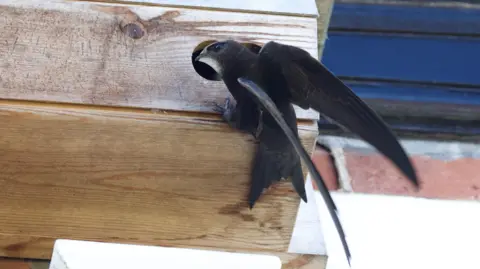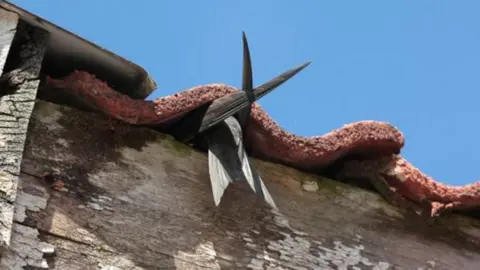Increase in nest boxes for visiting swifts
 Save Our Suffolk Swifts
Save Our Suffolk SwiftsThe number of nest boxes used by an endangered bird to breed has increased in the past year, according to the Suffolk Bird Group.
The number of swifts using nesting boxes in Suffolk has risen from 263 to 379 in 2024, and they have been placed in eight new locations across the county - on top of what individual home owners may have done.
Eddie Bathgate, from Suffolk Bird Group, said the population of the birds across the UK had "been in steep decline over the last 30 years" due to the "loss of their nest sites in older buildings during renovation works".
Swifts fly to the UK from Africa each spring to breed, and nest boxes in Suffolk are being installed for colonies to expand.
Swifts have a short forked tail and very long swept-back wings that resemble a crescent or a boomerang.
They can fly at 69 mph (111 km/h), making them the fastest recorded birds at level height.
The estimated average population fell by more than 50% in the UK between 1995 and 2016, from 125,500 to 59,000.
The Save Our Suffolk Swifts campaign has previously urged people to take on the challenge of protecting swifts as their numbers fall.
Mr Bathgate said: "St John's Church in Bury St Edmunds had 58 pairs nesting in cabinets behind the belfry louvres in 2024, a colony that started 10 years ago."
 Save Our Suffolk Swifts
Save Our Suffolk SwiftsIn total, 379 nest boxes were reported to be used by swifts in 87 different locations in Suffolk last year, the group said.
The group added that in 2023 about 263 boxes were used across 79 locations in the county.
It can take several years for the birds to find a new nest box and they might not breed for another year or two afterwards.
In 2024 about 130 nest boxes were donated and placed near to where the swifts were already nesting.
"Swift nest boxes also help other species; house sparrows and starlings are also red-listed in decline and will take to them," said Mr Bathgate.
"Swift boxes provide great space for nature."
Follow Suffolk news on BBC Sounds, Facebook, Instagram and X.
